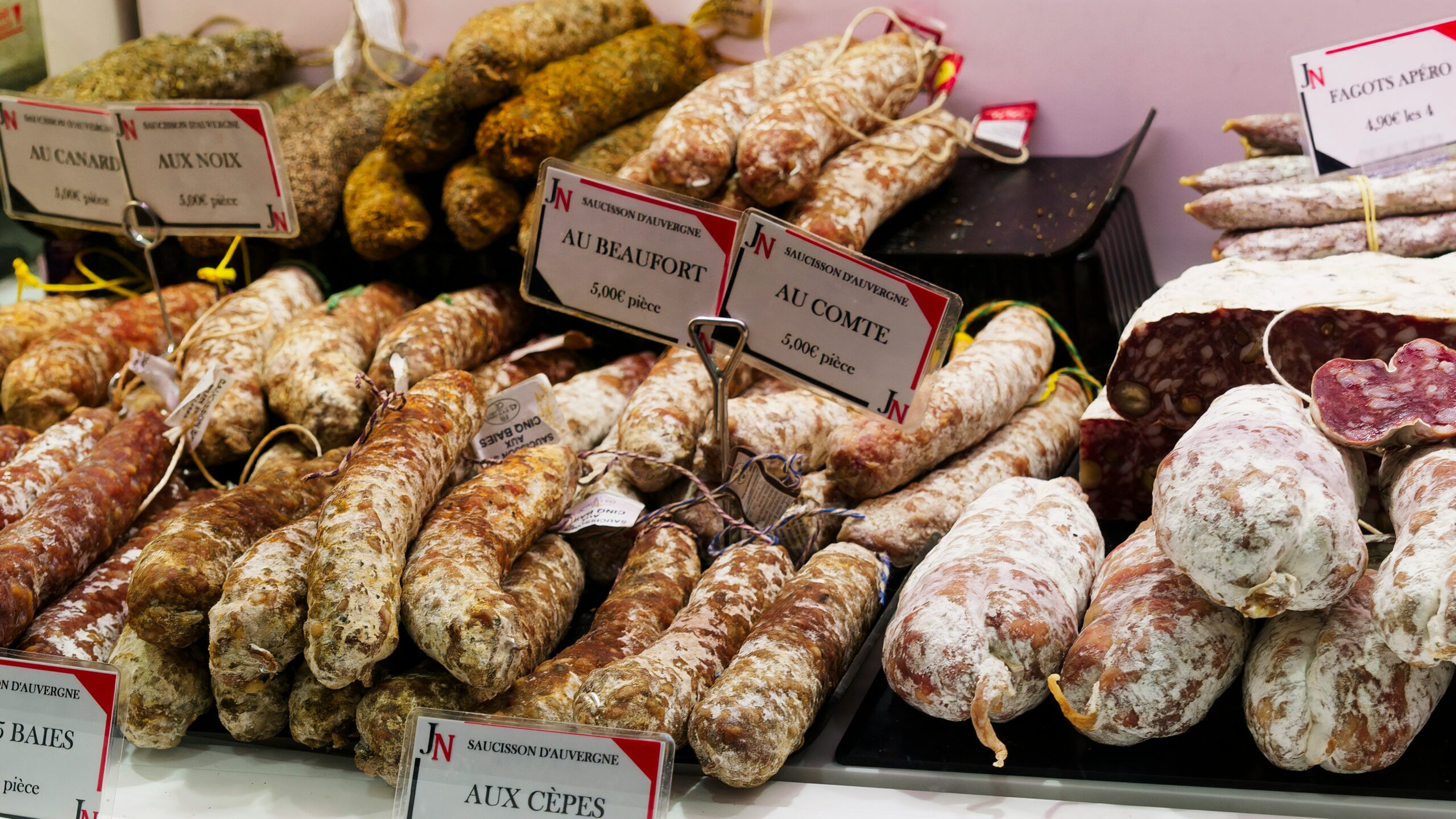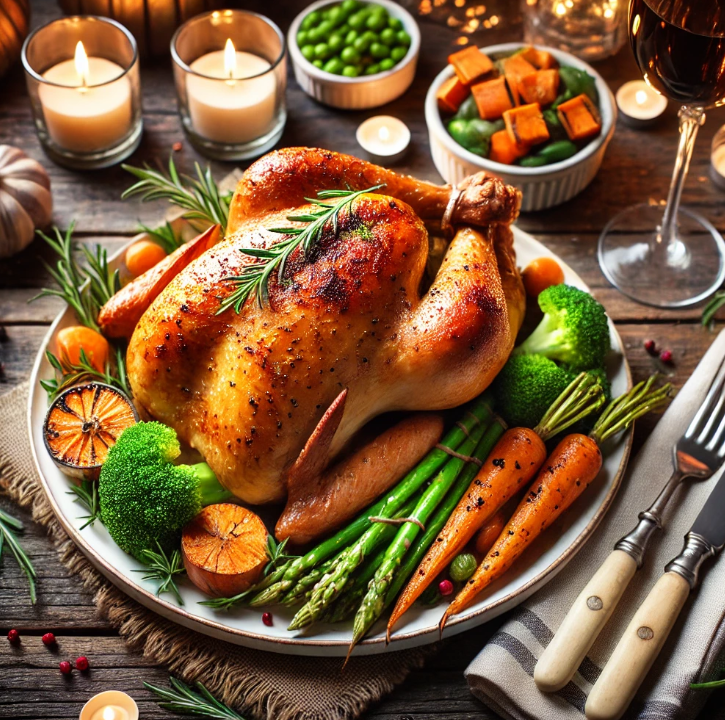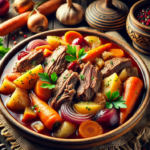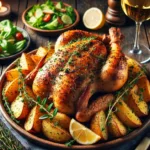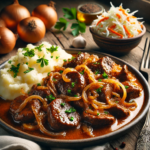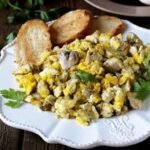Oven-Roasted Goose with Aromatic Herbs – A Festive Recipe with Authentic Taste and Delicate Flavors
Oven-roasted goose is a special dish, perfect for festive meals or occasions when you want to impress with a table rich in flavors. With its crispy skin and succulent meat, this roasted goose is a refined choice, enhanced by the delicate aromas of thyme, rosemary, and garlic.
This simple yet impactful recipe involves careful preparation of the goose, seasoned with salt, pepper, and fresh herbs, then slow-roasted for several hours. Lemon slices placed inside add a subtle note of freshness, while butter and the goose’s own juices turn the roast into a true feast. The goose develops a golden crust, and the interior remains tender and juicy, with a rich, savory flavor.
Served alongside vegetables roasted in the pan juices, oven-roasted goose is an elegant dish that brings warmth and good taste to the festive table. A classic and sophisticated recipe that highlights the natural flavor of goose meat, it’s the ideal choice for an unforgettable dinner with loved ones.
Oven-Roasted Goose with Aromatic Herbs

Ingredients:
- 1 whole goose (approximately 3–4 kg)
- 4–5 cloves of garlic, crushed
- 1 lemon, sliced
- 1–2 sprigs of fresh rosemary
- 1–2 sprigs of fresh thyme
- Salt and pepper, to taste
- 50 ml olive oil
- 200 ml chicken broth or water
- Vegetables for garnish (carrots, onion, potatoes)
Preparation:
- Preheat the oven to 180 °C.
- Wash and clean the goose thoroughly, then pat it dry with paper towels. Rub it with olive oil and season generously with salt and pepper, both outside and inside.
- Stuff the cavity with garlic, lemon slices, and the sprigs of rosemary and thyme.
- Place the goose in a deep roasting pan and pour in the chicken broth or water. Cover the pan with aluminum foil and roast for about 2 hours.
- After 2 hours, remove the foil and let the goose brown beautifully, turning occasionally, for another 1–1.5 hours.
- Serve the goose with the roasted vegetables cooked in the pan juices.
Pairing Suggestions
For oven-roasted goose, a few drink options enhance the rich, succulent flavors of the dish:
- Dry or Off-Dry Red Wine: Goose’s fatty, rich meat pairs perfectly with a dry or off-dry red wine. Choose one with fine tannins to balance the meat’s fat and accentuate its aromas. Suitable examples include:
- Pinot Noir – an elegant, light, and fruity wine that complements the goose beautifully.
- Merlot – a smoother wine with red fruit notes, offering a balance between freshness and body.
- Cabernet Sauvignon – if you prefer a fuller-bodied wine, opt for one with moderate tannins so it doesn’t overpower the roast.
- Dry White Wine: A fuller-bodied dry white can be a pleasant alternative, especially if the goose is accompanied by a citrus or herb sauce. Examples:
- Chardonnay – an oak-aged Chardonnay with buttery and woody aromas that pair well with goose meat, offering a sense of freshness.
- Sauvignon Blanc – provides a citrus and mineral note, fitting for an aromatic roast.
- Rosé Wine: For an intermediate choice, a dry, fruity rosé works excellently. Its fresh fruit notes and acidity make it suitable for festive meals and goose meat.
- Sparkling Wine: For an extra touch of refinement, a brut sparkling wine is perfect. The fine bubbles and acidity offer a pleasant freshness and help balance the roast’s texture.
- Țuică or Palincă (in small quantities, as an aperitif): For a traditional note, begin the meal with a small glass of țuică or palincă. This prepares the palate for the rich meal, but should remain an aperitif to avoid overshadowing the main dish’s flavor.
These sophisticated beverages beautifully complement the roast goose, turning the meal into a complete culinary experience.nsformând masa într-o experiență culinară completă.
- Rich stone fruit aromas of apricot and white peach are a feature of this wine, nicely complemented with a touch of honey…
- This is a flavoursome wine with a soft, smoothcreamy palate. It has the great sweet tropical fruitand melon flavours of …
- A versatile wine which makes a greataccompaniment to most food, in particular creambased pasta and succulent roast chick…
- Unit count: 1080.0
- Alcohol content: 11
- Country string: Australia
- Kumala Zenith Chenin Blanc Chardonnay is a full bodied dry white wine.
- It is a beautifully balanced dry white wine with tropical fruit flavours, a soft creamy texture and a subtle hint of Fre…
- Tropical fruit aromas of pineapple are married with toasty vanilla oak flavours to give a delicious, creamy finish.
- Great on its own or ideal with full flavoured chicken dishes, Thai cuisine and vegetarian dishes.
- Fine as an aperitif but chill for at least two hours and you’ll find this wine a brilliant match for a Thai curry
- alcohol volume may vary
- Big body, big flavour
- Fine as an aperitif but chill for at least two hours and you’ll find this wine a brilliant match for a Thai curry
- Chenin Blanc Chardonnay – White South African Wine
- Colour: a soft Chardonnay white wine with straw hues
- Nose: peach, fig and tropical fruit aromas emanate from the wine glass with underlying notes of toasty oak
- Palate: a mixture of fruit and oak create a medium bodied white wine a crisp finish
- Food pairing: this Lindeman’s chardonnay white wine pairs well with seafood, pasta, chicken and veal
- Peak Drinking: this bottle of white wine is best enjoyed fresh and cool, served straight away
- Since 1995, Banrock Station’s global environmental donations have exceeded GBP3m across more than 130 projectes in 13 co…
- From wildlife conservation in the UK and saving salmon in Canada, to wetland & waterway preservation in Australia and he…
- Fresh citrus aromas with flavours of tropical fruits & fresh pineapple, with a crisp finish – enjoy on its own, with chi…
- Ideal for everyday or dining at home
- Keeps wine fresh for 6 weeks
- Package may vary
- Straw yellow colour with lifted aromas of stonefruits peaches and cream and spicy oak
- Notes of melons coupled with stonesfruits all carried onto the palate and supported by a creamy oak backbone
- The fruit sweetness is balanced by the acidity which drives the lingering finish of butterscotch and spice
- Suitable for vegetarians and vegans
- Chardonnay wine from Victoria
- Winner of ‘Easy Weekday White Supermarket Own Label’ at the People’s Choice Wine Awards
- Product of Australia
- Contains sulphites
- Refreshingly unoaked, citrus and white peach flavours combine with a zesty fresh acidity and a clean, bright and linear …
- Perfect with tempura fried vegetables or crispy Chinese pork
- Juicy and full-bodied wine .
- Rich tropical fruit flavours and a hints of oak.
- Perfect with chicken dishes.
- Confident, elegant, gorgeous
- Wine of South Eatsern Australia
- Rich, Toasty and Buttery
- Vanillin, nougat and toasted nut flavours with a ripe peach and citrus fruit finishing with a soft jammy mouthfeel
- Drink slightly chilled at 10-13 Degree C
- Perfect for pairing with chicken and pork, creamy pasta, spicy seafood and Asian influenced dishes and salads
- Best enjoyed young
- Pineapple, citrus and peach-flavoured
- Floral scents
- Wine of Chile
- Medium bodied with good balance and a fresh finish
- 13.5% vol
- A tantalisingly creamy yet crisp, clean chardonnay
- Pale golden straw in colour with vibrant green hues
- Lifted aromas of freshly cut white peaches, citrus and honeydew melon
- Underlying hints of nougat, nutmeg and cinnamon spice add complexity to the bouquet
- Tropical over tones and a zesty finish
What makes oven-roasted goose with aromatic herbs such a special dish and fitting for festive occasions?
Oven-roasted goose is considered special thanks to its rich, naturally flavored meat and succulent texture. Herbs like rosemary, thyme, and garlic intensify the flavor, and when paired with butter and the goose’s own juices, they create a thick, delicious sauce. Moreover, the final presentation—with its crispy, golden-brown skin—makes it an ideal choice for any festive meal, bringing an air of refinement and authentic flavor.
How is the goose prepared before it goes into the oven?
First, the goose must be thoroughly washed and dried, both inside and out, to remove excess moisture. Proper drying ensures a crispy crust. Next, massage the goose with a mixture of olive oil (or melted butter), salt, pepper, and aromatic herbs—typically rosemary, thyme, and crushed garlic. For extra freshness, you can place lemon slices inside the cavity.
Why is it recommended to use chicken broth or water in the roasting pan during cooking?
Adding chicken broth or water provides a moist environment, preventing the meat from drying out and helping it stay tender. Additionally, the liquid at the bottom of the pan, mixed with rendered fat, can be used for basting the goose periodically, resulting in a deep brown crust and added flavor. The remaining liquid also serves as a base for a rich gravy.
How do you achieve both crispy skin and succulent meat at the same time?
The key is a two-stage cooking process: start by covering the goose with aluminum foil and roasting at a lower temperature (around 180 °C) to allow the meat to tenderize. Then remove the foil, increase the heat (to 200–220 °C), and baste regularly with the pan juices. This develops a golden, crispy skin while keeping the interior juicy and perfectly cooked.
How can you maintain an authentic Romanian flavor in the “haiducească” goose recipe?
Authenticity is preserved by using traditional ingredients such as fresh thyme and rosemary, Romanian garlic, and natural butter. Adding homemade broths (chicken or beef) and simple seasoning with salt and pepper aligns with the rustic, hearty style of haiduc cuisine. Slow roasting ensures the flavors develop naturally.
Which vegetables or side dishes best complement this oven-roasted goose?
To balance the goose’s richness, consider sides like roasted potatoes (even cooked alongside the goose), caramelized carrots, or red beets. Another popular choice is root vegetables (parsnips, celery root, parsley root) roasted in the pan juices, which soak up the goose’s aromatic flavors. Simple salads and pickles provide freshness and a contrasting taste.
How can the pan juices and fat left over after roasting be used?
The pan juices and fat are a valuable resource. Strain them, skim off excess fat, and use the resulting liquid as a base for a tasty sauce (thickened with a bit of flour or starch). Goose fat is also prized in traditional cooking for frying potatoes or other vegetables, thanks to its intense flavor and high smoke point.
What beverages pair well with oven-roasted goose, and how do they influence the dining experience?
Classic choices include a dry or off-dry red wine (such as Pinot Noir or Merlot) with moderate tannins to balance the rich meat. A full-bodied white wine (for example, an oaked Chardonnay) can highlight the goose’s succulent texture. For those preferring lighter drinks, a brut sparkling wine brings freshness, while a dry rosé offers a fruity balance. The right wine pairing elevates the dish’s complex flavors.
Is it difficult for a novice cook to prepare oven-roasted goose?
Although it requires extra time and attention to detail, the recipe is not necessarily complicated. Following key steps—such as properly drying the goose, rubbing with seasonings, and monitoring the optimal roasting temperatures—ensures success. Periodic basting and adjusting oven temperatures can be managed even by someone with limited kitchen experience, as long as they adhere to the recipe.
How can the recipe be customized to suit individual tastes?
To add creativity, experiment with different herbs—from basil to oregano. For a stronger flavor, tuck whole garlic cloves inside the goose, or use orange slices instead of lemon for a sweet-citrus note. Sprinkle a touch of ground chili for heat, or replace chicken broth with dry white wine to intensify the sauce’s flavor. Adjusting cooking times and seasonings allows each cook to put a personal stamp on this festive dish.











